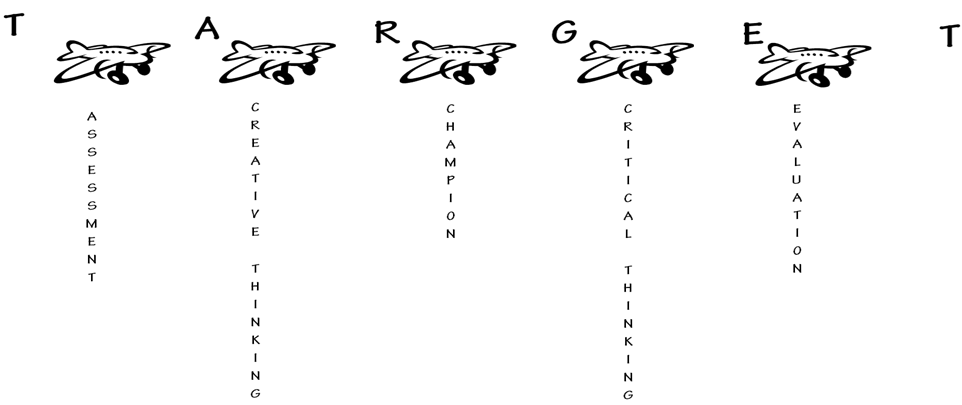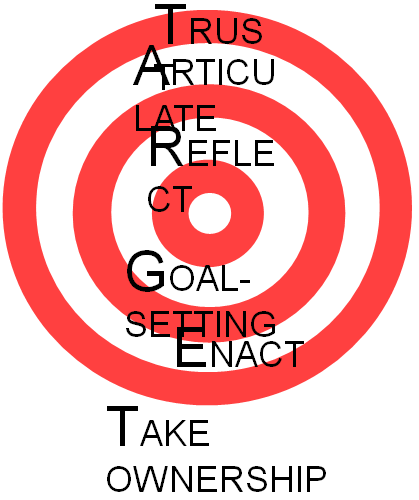A Coaching Model Created by Vanessa Weyland
(Life Coach, UNITED STATES)

An ideal way to envision this process is by viewing the client as the pilot and the coach as navigator. Some have compared the coach-client relationship to pilot and co-pilot; this analogy implies that at some point the coach will assume the controls. This is not the case. The coach-as-navigator’s duties are to help plan the route, control the course, control the time, and get over the target. In other words, the navigator is the pilot’s guide. In the TARGET model, the coach is functioning in a similar capacity as a navigator. The following will illustrate the client’s and the coach’s steps involved with the TARGET model. The navigator-coach will follow the ACCCE (“ace”) model for client development.
Client: Trust
As with any coaching relationship, the process begins with establishing and building Trust. Trust is the cornerstone of the TARGET coaching model. For any coaching relationship to be successful, the client must trust the coach, and be willing to share information they would normally only reserve for close, trusted friends and family. Establishing trust ensures that the client knkows they are in a safe place, they are able to brag or gripe, and that the coach will never reveal personal information (including information regarding the mere establishment of a coaching relationship without the client’s prior consent). During this phase, the coach is also building rapport and assisting the client in crating the context for the coaching relationship.
Coach: Assessment
Once the relationship has begun and trust has been established, the coach will then assess the client, either through personality-based assessments (DiSC, MBTI), performance-based assessments (360-Degree Assessment), or thorough, powerful questioning. This information will create a baseline of the client’s various styles (communication, work, engagement, problem solving, etc.) for the coach to work with going forward. When the coach is able to gain information to create a solid baseline of personality and styles, the client is able to focus on articulating and presenting their challenge. If used, the personality or performance assessment will not be an online, free assessment; the coach should be certified or knowledgeable enough to administer and interpret the assessment results. The coach uses any and all data-gathering methods to gain insight into the “issue” confronting the client.
Client: Articulate
In this stage, the client should be able to articulate their problem, challenge, issue, or be able to visualize what their end-state should/could be. At this point, the client is able to say “I want to do THIS, but I feel that I can’t because of THIS.” At this point, the coach instructs the client on learning how to learn and how to apply that experience. The coach also uses positive inquiry to explore and define the current situation or “issue” troubling the client.
Coach: Creative Thinking
Once the client has clarified their challenge, the coach should instruct the client in the finer points of creative thinking. Specifically, the coach is teaching the client to brainstorm on the issue, without discarding or judging any thoughts or ideas. The coach should be competent in instructing others in creative thinking, creative problem solving, and brainstorming. In this stage, the coach should focus on helping the client define the “facts” surrounding the issue and generate ideas. There are no solutions defined at this point, only the possibilities, regardless of implausibility.
Client: Reflect
Now that the client has been instructed in thinking creatively, she should now reflect on all possible solutions related to her problem. During this stage, the coach should ask the right questions to elicit solutions without criticizing or dismissing them. The coach should also be able to present the questions without guiding the client towards a “right” or “wrong” solution at this point. In this stage, the coach should also gain insight as to the client’s preferred way of problem solving.
Coach: Champion
Ideally, the client and coach have now had a few sessions. The client may lose steam, start finding reasons to postpone or quit the coaching relationship, or veer off into new topics without completing the original conversation. The coach now helps the client remember why they started the relationship, will motivate the client to stick with the process, inspire their client to greatness, and will cheer the client on towards creating their goals.
Client: Goal-Setting
Now the client is able to set the goals they want to achieve. These goals should be simple and achievable, and the goal statement should reflect this. This is the visualization of what the end-state will look like, but not the process to get to that end-state. A typical client statement at this point might be
When I solve THIS, my life/career/business will look like THIS.
This step is informed by goal-setting theories.
Coach: Critical Thinking
The coach should now instruct the client on proper ways to conduct critical thinking. The previous list of possible solutions (pre-goal-setting) is now being judged, and undesired solutions discarded. This step might also evoke new solutions or processes towards realizing the end-state. Some brainstorming on action steps is done here, if necessary, but the coach is focused on those powerful questions that will encourage the client to think tactically. At this stage, the individual tasks needed to achieve the goal are codified.
Client: Enact
The client is now free to take action. The decided solution is now implemented, and the client should be able to start realizing the original goals. Obstacles are eliminated here, and the client feels a freedom to become the owner of their own career, body, or business. The client is guided by the coach, who provides the client with success principles and application.
Coach: Evaluation
The coach now evaluates the client’s course of action, with small bits of necessary advice and guidance. If you recall, the coach is the navigator to the client’s role as pilot, providing the information on course corrections, but not directing or taking control of the “plane” at any point. This enables the client to start the final step, Taking Ownership.
Client: Take Ownership
Once the goals have been established and the client has begun enacting their solution, the client and coach are able to dissolve the coaching relationship. Steps in this stage are to:
- acknowledge successes and story board failures;
- compare the original vision with the end-state, and
- obtain client testimonials.
Further needs should also be identified at this stage, at which point the coach-client relationship will – TARGET – a new challenge.
